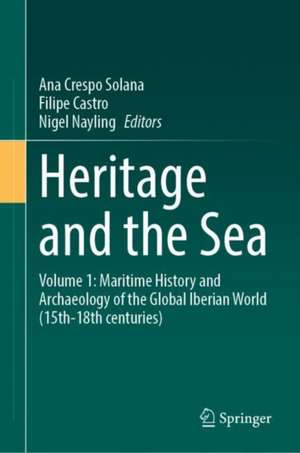Heritage and the Sea: Volume 1: Maritime History and Archaeology of the Global Iberian World (15th-18th centuries)
Editat de Ana Crespo Solana, Filipe Castro, Nigel Naylingen Limba Engleză Hardback – 28 dec 2021
Volume 1 focuses on the history and archaeology of seafaring and shipbuilding in the Iberian early modern world, complemented by case studies on timber trade and supply for shipbuilding, analysis of shipbuilding treatises, and the application of Geographic Information Systems and Databases (GIS) to the study of shipwrecks.
| Toate formatele și edițiile | Preț | Express |
|---|---|---|
| Paperback (2) | 1001.95 lei 43-57 zile | |
| Springer International Publishing – 16 mar 2023 | 1001.95 lei 43-57 zile | |
| Springer International Publishing – 29 dec 2022 | 1003.24 lei 43-57 zile | |
| Hardback (2) | 1008.12 lei 43-57 zile | |
| Springer International Publishing – 16 mar 2022 | 1008.12 lei 43-57 zile | |
| Springer International Publishing – 28 dec 2021 | 1009.22 lei 43-57 zile |
Preț: 1009.22 lei
Preț vechi: 1230.76 lei
-18% Nou
Puncte Express: 1514
Preț estimativ în valută:
193.11€ • 202.17$ • 159.79£
193.11€ • 202.17$ • 159.79£
Carte tipărită la comandă
Livrare economică 07-21 aprilie
Preluare comenzi: 021 569.72.76
Specificații
ISBN-13: 9783030864590
ISBN-10: 3030864596
Pagini: 373
Ilustrații: IX, 373 p. 22 illus.
Dimensiuni: 155 x 235 mm
Greutate: 0.71 kg
Ediția:1st ed. 2022
Editura: Springer International Publishing
Colecția Springer
Locul publicării:Cham, Switzerland
ISBN-10: 3030864596
Pagini: 373
Ilustrații: IX, 373 p. 22 illus.
Dimensiuni: 155 x 235 mm
Greutate: 0.71 kg
Ediția:1st ed. 2022
Editura: Springer International Publishing
Colecția Springer
Locul publicării:Cham, Switzerland
Cuprins
Chapter1. Remains of the shipwreck: an introduction to the Iberian maritime and underwater landscape.- Chapter2. A paradigm of inter and multidisciplinary research: The ForSEAdiscovery project as a case study.- Chapter3. Life and Death in the Spanish Carrera de Indias: ships, merchants, cargoes and routes.- Chapter4. Iberian Ships of the Early Modern Period.- Chapter5. Ship Types in Portugal.- Chapter6. The Iberian Peninsula between two Seas: Shipbuilding Revolution in the Mediterranean and the Atlantic Ocean, 14th–15th centuries.- Chapter7. An insight into Mediterranean naval architecture in the 16th century through the texts of Nicolò Sagri (1538–1571). A comparative perspective with Ibero-Atlantic shipbuilding.- Chapter8. From the Baltic Sea to Andalusia: North European timber (and traders) in 16th-century Seville.- Chapter9. Supplying timber for His Majesty’s fleets: forest resources and maritime struggle in Portugal (1621–1634).- Chapter10. Historical Documents assources for the study of shipbuilding in Spain.- Chapter11. Iberian Documents and Treaties on shipbuilding.- Chapter12. Maritime vocabulary in texts: Fray Joseph de Ledesma (1701).- Chapter13. GIS application on 16th-18th centuries Iberian Shipwrecks.
Recenzii
“The reader will find well-balanced multi-author chapters that result in a coherent, unified volume. The original outcomes compiled by Crespo Solana, Castro, and Nayling reveal the potential of transcending disciplinary boundaries and sharing in research. This work will soon become a major reference for both scholars and students of archaeology and history interested in early modern European nautical technology, shipbuilding, and seafaring.” (Nicolas C. Ciarlo, The International Journal of Nautical Archaeology, September 18, 2023)
Notă biografică
Dr. Ana Crespo Solana is a Professor and Researcher for the Spanish National Research Coucil, Instituto de Historia, Consejo Superior de Investigaciones Científicas (CSIC).
Dr. Filipe Castro is a researcher at História, Territórios e Comunidades, Center for Functional Ecology, Lisboa, Portugal.
Prof. Nigel Nayling holds the Chair in Archaeology at the Institute of Education and Humanities at the University of Wales Trinity Saint David.
Textul de pe ultima copertă
This two-volume set highlights the importance of Iberian shipbuilding in the centuries of the so-called first globalization (15th to 18th), in confluence with an unprecedented extension of ocean navigation and seafaring and a greater demand for natural resources (especially timber), mostly oak (Quercus spp.) and Pine (Pinus spp.). The chapters are framed in a multidisciplinary and interdisciplinary line of research that integrates history, Geographic Information Sciences, underwater archaeology, dendrochronology and wood provenance techniques. This line of research was developed during the ForSEAdiscovery project, which had a great impact in the academic and scientific world and brought together experts from Europe and America. The volumes deliver a state-of-the-art review of the latest lines of research related to Iberian maritime history and archaeology and their developing interdisciplinary interaction with dendroarchaeology. This synthesis combines an analysis of historical sources, the systematic study of wreck-remains and material culture related to Iberian seafaring from the 15th to the 18th centuries, and the application of earth sciences, including dendrochronology. The set can be used as a manual or work guide for experts and students, and will also be an interesting read for non-experts interested in the subject.
Volume 1 focuses on the history and archaeology of seafaring and shipbuilding in the Iberian early modern world, complemented by case studies on timber trade and supply for shipbuilding, analysis of shipbuilding treatises, and the application of Geographic Information Systems and Databases (GIS) to the study of shipwrecks.
Volume 1 focuses on the history and archaeology of seafaring and shipbuilding in the Iberian early modern world, complemented by case studies on timber trade and supply for shipbuilding, analysis of shipbuilding treatises, and the application of Geographic Information Systems and Databases (GIS) to the study of shipwrecks.
Caracteristici
Highlights the importance of Iberian shipbuilding, wood provenance and timber trade Provides a historical-archaeological analysis of Iberian shipwreck sites Applies Geographic Information Systems and Databases (GIS) to the study of shipwrecks
